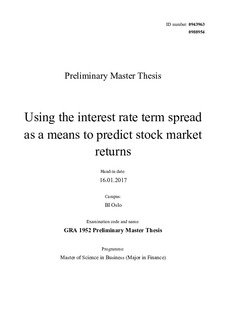| dc.description.abstract | We research an investment strategy; the Asset Allocation Model, incorporating
the difference between long-term and short-term interest rate – the interest rate
term spread – as a leading indicator for asset class allocation. Intuitively, a
positive spread implies higher economic growth in the future, which should
eventually propagate to the stock markets. Using the term spread, we create a
categorical dummy variable which signals investment in the stock market in
positive spread periods and no exposure to stock (risk) in negative spread periods.
By the Efficient Market Hypothesis, all available information and expectations
about future economic growth should already be reflected in stock prices and
exploiting information from the debt markets should not yield any persistent
abnormal returns.
The model is tested in ten sample economies; the US, the UK, Japan, Norway,
Denmark, Sweden, Germany, Finland, Switzerland and China, using historical
data from 10-year government bonds, 3-month Interbank Offered Rates and the
major stock market indices from the respective markets.
We find evidence that the Asset Allocation Model has been able to outperform the
market index in every sample economy both in absolute cumulative returns and by
the risk-adjusted Sharpe ratio, with satisfactory statistical significance in seven out
of ten countries (excl. UK, China and Japan). We argue that the interest rate term
spread contains information that is not reflected in the stock market, with the
implication that the Efficient Market Hypothesis does not truly hold in its semistrong
form. We also emphasize that the good results are largely attributable to the
model’s ability to predict the heaviest stock market declines. Although the results
are very interesting and statistically significant, we advise caution on the
consistency of the results out of sample due to relatively short research periods,
and the nature of financial markets characterized by structural changes. | nb_NO |

